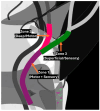Unveiling Guyon's Canal: Insights into Clinical Anatomy, Pathology, and Imaging
- PMID: 40075839
- PMCID: PMC11899079
- DOI: 10.3390/diagnostics15050592
Unveiling Guyon's Canal: Insights into Clinical Anatomy, Pathology, and Imaging
Abstract
Guyon's canal, or the ulnar tunnel, is a critical anatomical structure at the wrist that houses the ulnar nerve and artery, making it susceptible to various pathological conditions. Pathologies affecting this canal include traumatic injuries, compressive neuropathies like ulnar tunnel syndrome, and space-occupying lesions such as ganglion cysts. Ulnar tunnel syndrome, characterised by numbness, tingling, and weakness in the ulnar nerve distribution, is a prevalent condition that can severely impair hand function. The canal's intricate anatomy is defined by surrounding ligaments and bones, divided into three zones, each containing distinct neural structures. Variations, including aberrant muscles and vascular anomalies, can complicate diagnosis and treatment. Imaging techniques are essential for evaluating these conditions; ultrasound provides real-time, dynamic assessments, while magnetic resonance imaging (MRI) offers detailed visualisation of soft tissues and bony structures, aiding in pre-surgical documentation and pathology evaluation. This review article explores the anatomy, pathologies, and imaging modalities associated with Guyon's canal and underscores the necessity of understanding Guyon's canal's anatomy and associated pathologies to improve diagnostic accuracy and management strategies. By integrating anatomical insights with advanced imaging techniques, clinicians can enhance patient outcomes and preserve hand function, emphasising the need for increased awareness and research in this often-neglected area of hand anatomy.
Keywords: Guyon’s syndrome; MRI scan; diagnostic ultrasound; ganglion cyst; ulnar nerve entrapment at the wrist.
Conflict of interest statement
The authors declare that they have no conflicts of interest.
Figures


















References
-
- Guyon F.C. Note on a special canal in the anterior annular ligament of the carpus for the passage of the ulnar artery. Comptes Rendus Soc. Biol. 1861;12:92–94.
-
- Ramage J.L., Varacallo M. StatPearls. StatPearls Publishing; Treasure Island, FL, USA: 2020. Anatomy, shoulder and upper limb, hand Guyon canal. - PubMed
-
- Aleksenko D., Varacallo M. StatPearls [Internet] StatPearls Publishing; Treasure Island, FL, USA: 2023. Guyon Canal Syndrome. - PubMed
-
- Becker R.E., Manna B. StatPearls [Internet] StatPearls Publishing; Treasure Island, FL, USA: 2023. Anatomy, Shoulder and Upper Limb, Ulnar Nerve. - PubMed
Publication types
LinkOut - more resources
Full Text Sources

